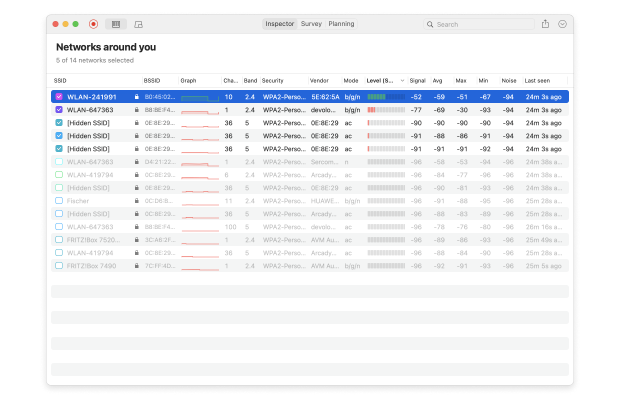Wi-Fi Site Surveys, Analysis, Troubleshooting runs on a MacBook (macOS 11+) or any laptop (Windows 7/8/10/11) with a standard 802.11be/ax/ac/n/g/a/b wireless network adapter. Read more about the 802.11be support here.
WiFi Calling Optimization with NetSpot
Optimize WiFi calling with NetSpot: perform Wi-Fi analysis, improve call quality, and eliminate dropped calls in areas with weak cellular coverage.
Wi-Fi calling, as the technology is known as, is already supported by most major carriers and modern smartphones.
Mobile network operators have been focusing on leveraging the existing WiFi networks, which are becoming denser and faster every year, to make phone calls possible even from areas with very poor cellular signal, such as the outskirts of a cellular signal in the countryside or inside buildings or basements.
What Is Wi-Fi Calling
Activating WiFi calling takes just a few seconds, and the benefits are instantly noticeable. What many people who activate it don’t realize, however, is that WiFi calling shifts the responsibility for network optimization from the carrier to the end user.
Wi-Fi analysis and troubleshooting applications such as NetSpot are indispensable for achieving the best possible call quality and preventing WiFi calls from suddenly being interrupted due to poor WiFi coverage.
With the rise of next-generation wireless technologies like Wi-Fi 6 and Wi-Fi 6E, ensuring a properly optimized home WiFi network has become even more important for reliable WiFi calling. These standards support features like lower latency, increased capacity, and better performance in congested environments — making them ideal for voice over WiFi use cases.
To get the most from WiFi calling at home or in the office, users should also ensure their router supports QoS (Quality of Service) settings, which prioritize VoIP traffic and help reduce latency and jitter during voice calls.

Traditionally, when you make a phone call on your cell phone, you are connected to the person you’re calling through a cell phone tower. Cellular networks are comprised of many such towers, each emitting omnidirectional cell tower signals up to 100 watts of power.
Mobile network operators who own, maintain, and design these networks would like to cover every square inch with a strong, reliable cellular signal, but that’s unfortunately not always viable. Some areas are simply too out of reach or too scarcely populated to make it worthwhile for mobile network operators to construct expensive cell phone towers in such places.
Of course, a cellular signal isn’t always perfect even in major cities. Sometimes the signal doesn’t penetrate the thick walls of concrete buildings, sometimes it doesn’t reach far enough underground to cover subway stations and basements, and sometimes there’s so much interference that phone calls drop without any warning.
All of this is happening while nearly every household, every office, and every public place is covered with a strong WiFi signal. So, why not use it to make phone calls? From the carrier’s point-of-view, it’s just a simple matter of sending the same data over a different network. From the end user’s point-of-view, it takes just a few taps on the screen to activate the service, assuming WiFi calling is included in the end user’s plan.
Besides offering superior signal reception, WiFi calling also increases the audio quality of phone calls. Some mobile network operators support a feature called HD voice, which is high definition voice quality for telephony audio.
Instead of being limited to the range of 300 Hz to 3.4 kHz, like traditional cell phone calls are, it uses a much wider range of 50 Hz to 7 kHz or higher. Of course, higher audio quality means higher bandwidth requirements.
Do I Need a WiFi Calling App?
In a way, smartphone users have been making WiFi calls for years. Apps like Skype, Viber, and WhatsApp make it possible to place calls over WiFi for free, and they even let users send text messages, share files, and make video calls.
Collectively, these apps belong under the umbrella term VoIP (Voice over Internet Protocol). VoIP is defined as a methodology and group of technologies for the delivery of voice communications and multimedia sessions over Internet Protocol (IP) networks.
In other words, these apps use existing data networks such as the Internet for voice communications. Skype, Viber, and WhatsApp all operate on separate networks and don’t use the phone’s built-in dialer. Calling someone using these apps is possible only if the other party also has the app installed on his or her smartphone.
WiFi calling is built into the phone natively
WiFi calling is built into the phone natively. It uses the phone’s native dialer and contact list. There’s no need to install any additional app, and only the person who wants to make a phone call over WiFi must activate the feature — the other party can be connected to a cellular network.
For example, with iPhone, WiFi calling can be activated on any iPhone 5c or later. WiFi calling iPhone works similarly to WiFi calling Android.
As such, WiFi calling requires little to no setup, yet it comes with many of the benefits of VoIP apps like Skype, Viber, and WhatsApp. Some carriers offer free WiFi calling, while others don’t.
Free Wi-Fi Calling Optimization
When your Wi-Fi router becomes the gateway for calls, you take on the role of a mini network engineer. It's crucial to understand what your connection needs to deliver consistent, high-quality voice service.
Here’s a breakdown of what matters in 2025:
| Parameter | Recommended Value |
| Audio bandwidth | ≈0.1–1 MB / min (varies by EVS codec bitrate and IP overhead) |
| Minimum throughput | 300 kbps up / 300 kbps down, with jitter below 50 ms for smooth voice performance |
| Protocol support | Wi-Fi 6/6E (802.11ax) and early Wi-Fi 7 (802.11be) with OFDMA, MU-MIMO, and up to 320 MHz-wide channels |
Expert tip: If your voice breaks or lags, test your signal-to-noise ratio (SNR) and jitter levels with a tool like NetSpot. Even a fast Wi-Fi link can ruin voice quality if interference levels spike or if the AP is overloaded. Proper mesh placement and switching to less congested 5 GHz or 6 GHz bands can make a major difference.
FAQ
WiFi Calling is a service for smartphones that allows making calls over a Wi-Fi network. Your WiFi call is just like placing a regular call, but without using the cell tower. WiFi calling has a number of benefits, like the one when you are abroad and roaming data is very expensive. Your carrier usually determines whether you can make a WiFi call or not.
You don't have to install an additional app to make WiFi calls. However, you'll need the WiFi calling feature activated on your phone if you want to initiate the calls; the person you'll be calling doesn't need this feature to be activated on their phone, they will receive calls over cellular network, just as they always do.
WiFi Calling is a native feature of the majority of modern smartphones. If your phone is HD voice-enabled, then you can make WiFi calls after activating this feature in settings.
The Wi-Fi Calling feature is usually available at no additional cost, and is included in the existing monthly voice plan, however every operator is different and you have to check the pricing details with yours. Also, if you make international calls they most probably will be charged accordingly.
It works in principle, but the 500–700 ms RTT may cause echo and call setup delays. Note: as of 2025, Apple and Google only support emergency text via satellite. Full voice is planned by providers like Starlink Direct-to-Cell, but not yet launched.

WiFi calling increases the audio quality of phone calls